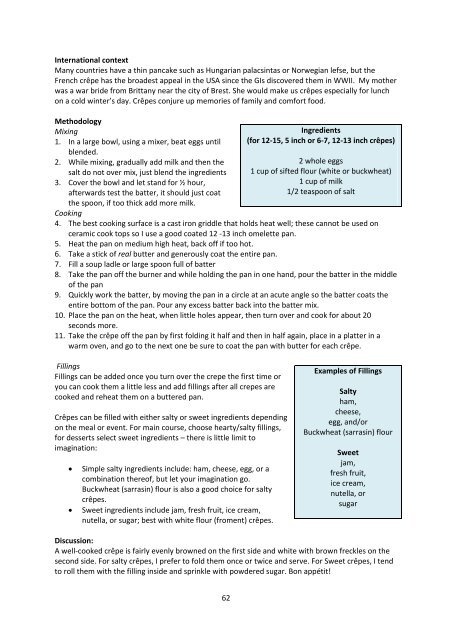AIB Cooking Book - Klaus Meyer homepage
AIB Cooking Book - Klaus Meyer homepage
AIB Cooking Book - Klaus Meyer homepage
You also want an ePaper? Increase the reach of your titles
YUMPU automatically turns print PDFs into web optimized ePapers that Google loves.
International context<br />
Many countries have a thin pancake such as Hungarian palacsintas or Norwegian lefse, but the<br />
French crêpe has the broadest appeal in the USA since the GIs discovered them in WWII. My mother<br />
was a war bride from Brittany near the city of Brest. She would make us crêpes especially for lunch<br />
on a cold winter’s day. Crêpes conjure up memories of family and comfort food.<br />
Methodology<br />
Mixing<br />
1. In a large bowl, using a mixer, beat eggs until<br />
blended.<br />
2. While mixing, gradually add milk and then the<br />
salt do not over mix, just blend the ingredients<br />
3. Cover the bowl and let stand for ½ hour,<br />
afterwards test the batter, it should just coat<br />
the spoon, if too thick add more milk.<br />
<strong>Cooking</strong><br />
4. The best cooking surface is a cast iron griddle that holds heat well; these cannot be used on<br />
ceramic cook tops so I use a good coated 12 ‐13 inch omelette pan.<br />
5. Heat the pan on medium high heat, back off if too hot.<br />
6. Take a stick of real butter and generously coat the entire pan.<br />
7. Fill a soup ladle or large spoon full of batter<br />
8. Take the pan off the burner and while holding the pan in one hand, pour the batter in the middle<br />
of the pan<br />
9. Quickly work the batter, by moving the pan in a circle at an acute angle so the batter coats the<br />
entire bottom of the pan. Pour any excess batter back into the batter mix.<br />
10. Place the pan on the heat, when little holes appear, then turn over and cook for about 20<br />
seconds more.<br />
11. Take the crêpe off the pan by first folding it half and then in half again, place in a platter in a<br />
warm oven, and go to the next one be sure to coat the pan with butter for each crêpe.<br />
Fillings<br />
Fillings can be added once you turn over the crepe the first time or<br />
you can cook them a little less and add fillings after all crepes are<br />
cooked and reheat them on a buttered pan.<br />
Crêpes can be filled with either salty or sweet ingredients depending<br />
on the meal or event. For main course, choose hearty/salty fillings,<br />
for desserts select sweet ingredients – there is little limit to<br />
imagination:<br />
• Simple salty ingredients include: ham, cheese, egg, or a<br />
combination thereof, but let your imagination go.<br />
Buckwheat (sarrasin) flour is also a good choice for salty<br />
crêpes.<br />
• Sweet ingredients include jam, fresh fruit, ice cream,<br />
nutella, or sugar; best with white flour (froment) crêpes.<br />
Discussion:<br />
A well‐cooked crêpe is fairly evenly browned on the first side and white with brown freckles on the<br />
second side. For salty crêpes, I prefer to fold them once or twice and serve. For Sweet crêpes, I tend<br />
to roll them with the filling inside and sprinkle with powdered sugar. Bon appétit!<br />
62<br />
Ingredients<br />
(for 12‐15, 5 inch or 6‐7, 12‐13 inch crêpes)<br />
2 whole eggs<br />
1 cup of sifted flour (white or buckwheat)<br />
1 cup of milk<br />
1/2 teaspoon of salt<br />
Examples of Fillings<br />
Salty<br />
ham,<br />
cheese,<br />
egg, and/or<br />
Buckwheat (sarrasin) flour<br />
Sweet<br />
jam,<br />
fresh fruit,<br />
ice cream,<br />
nutella, or<br />
sugar



